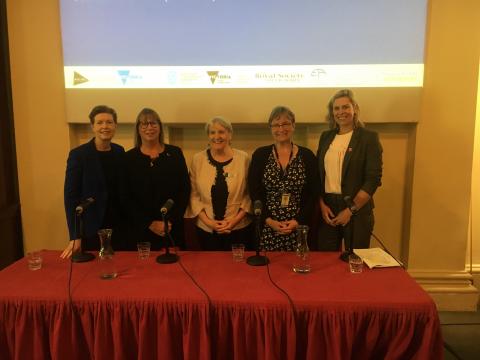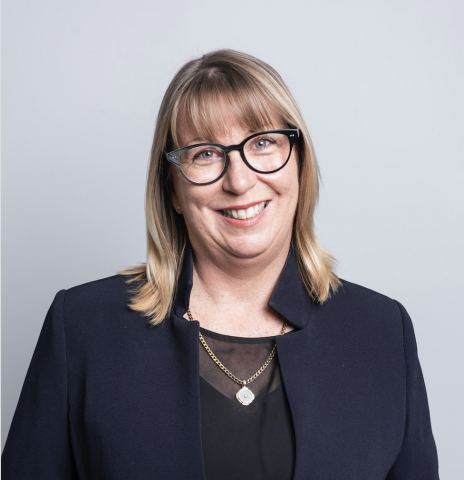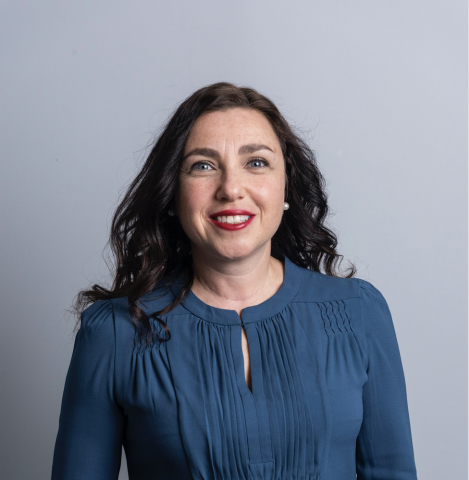
Happy International Day of Women and Girls in Science 2019. Our Office joined the EPA Victoria and some of Victoria's leading female scientists for a livestreamed event. Hosted by Victoria's Chief Environmental Scientist, Andrea Hinwood, the event featured a keynote address by co-founder and CEO of Women in STEMM Australia Dr Marguerite Evans-Galea. Students, teachers and interested Victorians could register for the livestream through Eventbrite.

The event also featured an interactive panel including, from left, Victoria’s Lead Scientist Dr Amanda Caples, Victoria’s Commissioner for Environmental Sustainability Dr Gillian Sparkes, Victoria's Chief Environmental Scientist Dr Andrea Hinwood and Victoria’s Deputy Chief Health Officer Dr Angie Bone. The session was facilitated by Director of the Office for Women in Sport and Recreation [BROKEN LINK] Dr Bridie O'Donnell. You can listen to the session here.
As part of #IWDGS2019, Commissioner Dr Gillian Sparkes and Senior Science Writer Dr Rebecca Koss were interviewed about their careers in science for EPA Victoria. We hope these interviews will inspire many women to embrace careers in science.

Q. Thinking back to the beginning of your life in science, was there a ‘spark’ or ‘a-ha!’ moment where you discovered a love of science or felt that ‘this is what I want to spend my life doing’?
A. When I was in year 11, I was lucky enough to have an exceptional science teacher. She was in her 20s and I thought she was cool! Her name was Allison and, in my experience, to be taught by a relatively young, vibrant female science teacher was unusual in the 1970s. Allison approached teaching differently to the traditional methods I had been used to in me maths and science classes. On day one, she introduced herself as Allison (calling teachers by their first name was very unusual in those days), and said she wanted us to learn and also have fun in our chemistry lessons together. I was completely engaged in her classes from that day and have maintained a passion for science ever since. Allison told us that she understood we all had different ways of learning so she taught us the periodic table for example, using practical lessons and various quizzes and games, to support the theory in text books. We would fire up the Bunsen burners and see changes happening in front of our eyes and relate that to what we were reading in the text books. As a person who ‘learns by doing’, I loved this approach. To be taught the periodic table and then experience the characteristics of the elements in action was a great combination for me. I thought ‘wow I can do this’ and so I did.
Q. Is there a particular place/environment you have visited for your work that has stuck with you? Perhaps an environment you wouldn’t have otherwise experienced? What work did you do there?
A. When I was doing my PhD in chemistry, I went to Connecticut in the USA to complete my experimentation and confirm the theories I was developing from my lab work in Adelaide. I specifically went to a facility to use a surface analysis technique called Secondary Ion Mass Spectrometry (SIMS). SIMS is a technique used to analyse the surfaces of particles and thin films and at that time, was not available to me in Australia. However, fortunately for me one of the industry partners in my research project, had a spectrometer in their Connecticut laboratory. So over I went to use SIMS and test whether the theory (around what molecule was being formed to help the copper minerals float when particular chemicals were added to them), that had been developed during more than two years of experimentation and research in my laboratory in Adelaide, stacked up. The power of SIMS to detect and identify surface species was ‘light-years’ ahead of the “wet chemistry” techniques I had undertaken up until then. On a beautiful Fall day in Connecticut and after much delicate preparation of the samples for testing, the SIM spectrometer produced a very clear and definitive spectrum with a peak at 267 to prove and consolidate my theory. I was so excited that I cried. On that day, I produced the evidence I needed to go home and write up my PhD thesis.
Q. What challenges in your career keep you excited/motivated to continue your work today?
A. I am a curious person by nature. I love learning, solving problems and helping others. There are always things to learn, problems to solve and people to help so I never have any trouble feeling excited and motivated in my work as Commissioner. I focus my energy on working with others to help protect and improve Victoria’s environment to benefit everyone. That’s what drives me. I am also deeply interested in new areas of science – especially data science and developments in spatial information. These emerging areas allow us to think differently about problems and open up new ways to use technology to solve wicked problems. The ability to access information is powerful and empowering for individuals and communities alike. When I began my career, chemists did a lot of experiments and benchwork in laboratories and used some spectroscopy, to solve problems. Now with the advent of the digital era and progress of technology we can use big data and analytics to solve and resolve many of the same problems – and do it at a faster pace, with higher resolution and greater reach than ever before. In my early career at BHP I would spend over 80% of my time doing experiments to test for contaminants in our waste water system. The chemical oxygen demand experiment for example, to test for oil in the waste water system could take up to eight hours to complete. Remote monitoring and sensor technology, the advent of big data and the digital age has exponentially improved our ability to scope and solve problems since I began my career as a trainee chemist with BHP. I continue to be amazed, excited and energised by the importance of science in our lives, in nature and for a healthy society and economy.
Q. For women interested/beginning a career in science, what emerging fields/research/environmental challenges do you think offer a rewarding avenue to pursue?
The use of data, spatial information, analytics and the advent of the digital era in general are the really big areas of science that have emerged in importance and relevance in every aspect of my work over the past decade. Sense-making, big data and spatial information enables us to understand challenges, measure change and respond to events based on facts, at a pace that our analogue models can’t compare with. These techniques will help us to solve emerging fields of great interest such as:
- how we deal with climate change impact and biodiversity loss
- how we continue to improve the availability and access of important, practical information on the environment for communities at the local level, in an accessible form and in real time
- how we sustainably manage our forests and river systems
- how we deal with waste as a society – everything from reducing waste overall to dealing with the impact of plastics on marine life. Improving our collective understanding of the impact of solid and liquid waste from our life on land, going into the sea, is a big challenge
- how we harness the power of citizen science
I believe that the more we know and understand as a community and the more that information is shared democratically and transparently, the better our democracy will work. Data science and digital, spatial technologies and the value of independent scientific research to build our capabilities in these areas, is greater than ever.

Q. Thinking back to the beginning of your life in science, was there a ‘spark’ or ‘a-ha!’ moment where you discovered a love of science or felt that ‘this is what I want to spend my life doing’?
A. I was 19, studying first year Science at Monash University and I remember walking through the zoological sciences building and I saw a huge poster of an octopus. The poster said: ‘Why not do marine science’? And I said, ‘Why not?’ That was it. I had grown up next to the beach, snorkelling all the time and always felt a great connectivity to the ocean. In that moment it all made sense.
Q. Is there a particular place/environment you have visited for your work that has stuck with you? Perhaps an environment you wouldn’t have otherwise experienced? What work did you do there?
A. As a Post-Doctorate Fellow at the University of Liverpool, UK, I worked on a European Union funded program called Options for Delivering Ecosystem-based Marine Management (ODEMM). I got to work across the Mediterranean, the Black Sea, the Baltic Sea, the North-East Atlantic developing new tools to measure how well EU countries were doing in achieving good environmental status for their regional seas. The worst beach I visited during that time was Magaluf, Mallorca from all the beer cans and cigarette butts mainly from British tourists; the best was Port de Soller, also in Mallorca.
Q. What challenges in your career keep you excited/motivated to continue your work today?
A. For me, the opportunities of new technology and how we can use this data, via the Internet of Things, to tell our environment stories in real time is very exciting. I am also really inspired by Boyan Slat. He’s a 24-year-old Dutch inventor, entrepreneur and aerospace engineering student drop out who is CEO of the Ocean Clean Up. Using an array of advanced IT systems, modelling capabilities and analytic tools, he has created a plastic catching system for dealing with ocean rubbish. I am also excited about how government, business, scientists and communities must collaborate to meet the challenges of climate change.
Q. For women interested/beginning a career in science, what emerging fields/research/environmental challenges do you think offer a rewarding avenue to pursue?
Waste and biodiversity loss are current key issues that have emerged through our research and reporting for the State of the Environment 2018 Report as well as our State of the Forests and State of the Yarra 2018 reports which are all released next month. In terms of careers, it is really important to keep an open mind about knowledge fields and looking for a multi-disciplinary approach to solving our biggest challenges. Looking ahead, I think science careers will become more interesting as the value of evidence-based science becomes clearer to government, business and the wider community. Research, development and data scientists and engineers will be in demand as we globally ramp up new technologies and innovations associated with artificial intelligence and the internet of things.
My top three in terms of short to long-term demand:
- Research, Development and Data Scientists
- Agricultural Scientists
- Environmental Scientists (for areas including water, energy, marine, air quality, waste, recycling)
